Plan Your Visit

The National Museum of African American History and Culture is open daily to the public. Free timed-entry passes are required for entry.
Hours
Monday 12:00 p.m. to 5:30 p.m.
Tuesday 10:00 a.m. to 5:30 p.m.
Wednesday 10:00 a.m. to 5:30 p.m.
Thursday 10:00 a.m. to 5:30 p.m.
Friday 10:00 a.m. to 5:30 p.m.
Saturday 10:00 a.m. to 5:30 p.m.
Sunday 10:00 a.m. to 5:30 p.m.
Our museum opens at 10:00 a.m. on Mondays observed as Federal Holidays and is closed on December 25.
Free Timed-Entry Passes
- All visitors, regardless of age, must have a timed-entry pass to enter the museum.
- A limited number of timed-entry passes are available.
- Visitors can reserve timed-entry passes up to 30 days in advance on a rolling basis.
- Advanced timed-entry passes are released daily beginning at 8:00 a.m. EST.
- Same-day timed-entry passes are released online only at 8:15 a.m. EST daily.
- Timed-entry passes may not be sold or transferred and are for personal use only.
- Individuals can reserve up to six free timed-entry passes for their visit. For groups of 10 or more, please reserve group passes.
- Veterans, active-duty personnel and first responders are welcome to the museum with one guest by presenting a military or work ID badge, without reserving a free-timed entry pass. Entry begins by joining the general line and checking in at the triage tents located near the building entrances on 15th Street and Madison Drive or 14th Street and Constitution Ave.
Please note: museum entry is subject to building capacity; weekends and holidays are peak visitation times. If the museum is at or near capacity, all visitors standing in line will be asked to wait until the museum has room to accommodate them.
Additional Information
- All children (under the age of 16) must be accompanied by an adult chaperone. At least one adult chaperone is required to accompany up to five children.
- Timed-entry passes are valid only for the issued date. Passes are void if altered.
- Visitors can print timed-entry passes at home or present them on a mobile device. All passes will be scanned prior to entering the museum on Madison Drive or Constitution Ave.
- If you cannot visit the museum on your scheduled date, you may cancel or exchange your pass for another day by completing this form.
Safety Measures
The following safety measures are in place to protect the health of our visitors, staff and volunteers based on guidance from the Centers for Disease Control and Prevention (CDC) and local governments. We ask that all visitors, including those who have been vaccinated against COVID-19, follow these safety measures to protect everyone’s health. Visitors are not required * to show proof of COVID-19 vaccination.
Please note that we may adjust our safety guidelines based on changing CDC COVID-19 Community Levels. We encourage visitors to regularly check our website before their visit for the latest guidelines. During this time, we are implementing the following safety measures:
If Sick, Stay Home
We are asking all visitors who are sick or feel unwell to please stay home. Visitors are encouraged to wash and sanitize hands frequently during their visit. Hand-sanitizing stations will be available throughout our facilities.
Face Coverings
As of March 11, face coverings are not required to visit the National Museum of African American History and Culture. While it will not be required, all visitors who feel more comfortable wearing a face mask during their visit are encouraged to do so.
We encourage visitors to maintain a safe social distance of six feet or more between households and groups when possible, but our museum becomes crowded, especially during peak visitation times. Visitors who wish to avoid crowds are encouraged to plan their visit during weekdays.
* Special events and some after-hours programming may require guests to provide proof of vaccination.
Touring the Museum
Please be aware that touring the History Galleries in their entirety will take approximately 2 hours, and will require about 1 mile of walking.
Our highest visitation is from 12:00 p.m. to 4:00 p.m., Friday through Sunday. During this timeframe, there may be long lines to access the History Galleries.
We encourage visitors to eat and hydrate before entering the History Galleries, especially if they have special healthcare needs.
Some exhibitions, interactives, and indoor spaces may be closed or operate at limited capacity to ensure the safety of our visitors.
Galleries & Interactives
- The Pavilion Theater remains closed to visitors.
- Some interactives, including the Reflection Booths and Digital Guestbook remain closed.
Entering & Exiting the Museum
- Please do not arrive before the entry time on your timed-entry pass.
- Timed-entry passes will be scanned at the visitor entrances on Madison Drive or Constitution Avenue, NW.
- Visitors with timed-entry passes will be able to enter the museum from the time on their pass until 4:00 p.m.
- For everyone’s safety, all visitors are required to pass through screening at the entrance to the museum. Please see a list of prohibited items in the museum before planning your visit.
- Limiting the items you bring will increase your speed through security checkpoints, helping us all maintain a safe social distance.
- Visitors are required to exit on Constitution Avenue, NW.
Dining & Shopping
The museum store is open daily, from 10:00 a.m. to 5:30 p.m. Hand sanitizer stations are available for use upon entry and exit of the museum store. The Sweet Home Café is open daily, from 11:00 a.m. to 3:00 p.m. with a limited menu.
NMAAHC offers a limited number of Dine and Shop passes to access only the Museum Store and Sweet Home Café between 11:00 a.m. – 2:30 p.m. during regular operating hours. Passes are released 48 hours in advance at 8:00 a.m. EST on a rolling basis. Visitors can reserve up to 2 Dine and Shop passes per day.
Frequently Asked Questions
Review our Frequently Asked Questions for more information about planning your visit and what to expect when you arrive at the museum.
Tours & Programs
Please check our upcoming events for specific dates and details.
Download Our Mobile App
Connect to our free WiFi network, “SI-Visitor” and download our mobile app as a complement to your museum visit and as a way to more easily discover the many additional stories in our collection.
Top 10 Facts about the National Museum of African American History and Culture

Top 10 Facts about the National Museum of African American History and Culture
The National Museum of African American History & Culture (NMAAHC) is the culmination of a centuries-long struggle to recognize the importance of the black community in the social fabric of American life. The museum houses exhibit galleries, administrative spaces, theatre space and collections storage space for the NMAAHC.
The Museum opened in Washington, D.C. on Sept. 24, 2016 and boasts an extensive collection of civil rights, music, photography, literature, and slavery-related items, as well as pieces in a host of other categories. The national African American museum idea dates back to 1929 when President Herbert Hoover appointed a building commission, which Congress ultimately failed to authorize. However, in 2003, President George W. Bush signed legislation for the museum to be built.
The National Museum of African American History and Culture is the only national museum devoted exclusively to the documentation of African American life, history, and culture. Established following decades of efforts to promote and highlight the contributions of African Americans to date, the museum has collected more than 40,000 artifacts and a membership of 100,000 individuals. The Museum opened its doors to the public as the 19th museum of the Smithsonian Institution. Continue reading this article to learn about the top 10 facts about the National Museum of African American History and Culture.
1. Symbolic African American Elements were Incorporated into the Museum’s Building Design
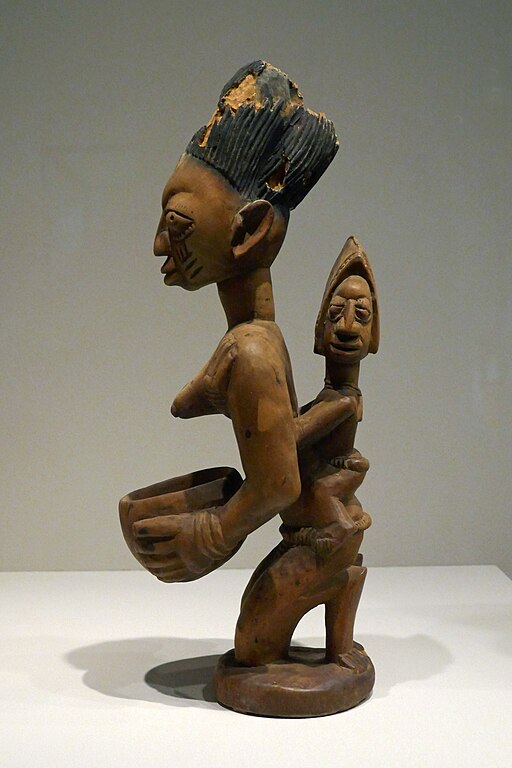
Image by Ji-Elle from Wikimedia
The design rests on three cornerstones: the “corona” shape and form of the building; the extension of the building out into the landscape – the porch; and the bronze filigree envelope.
Tanzanian-born British architect David Adjaye the lead designer said “This is a museum where the container and the content are one.” The five-story building is inspired by a Yoruban caryatid, which is a column popular in West Africa with a corona at its peak. The building’s patterns also allude to the architecture found in Georgia and South Carolina that was built by enslaved and freed Blacks. This metalwork inspired Mr. Adjaye and the bronze color and shape of the building is an additional aspect similar to that Southern style of architecture.
The whole exterior is wrapped in a metal lattice that resembles the ironwork traditionally forged by enslaved African Americans in cities such as Charleston and New Orleans. According to Architizer, “The architects studied iron railings and façade ornaments from South Carolina and Louisiana before selecting a historic grille as the basis of their design. They then used digital modeling software to abstract the pattern, giving it a contemporary flair.”
According to David Adjaye, he envisioned the museum evoking a sense of “praise.” He told Smithsonian Magazine, “It’s the idea that you come from the ground up, rather than crouching down or leaning. The form of the building suggests very upward mobility . . . This is not a story about past trauma. For me, the story is one that’s extremely uplifting, as a kind of world story. It’s not a story of a people that were taken down, but actually, a people that overcame and transformed an entire superpower into what it is today. The sacrifices of the African-American people have made America better.”
2. The Difficult Push to create this Museum Began in the 1800s

Image by ACE-IT NAB from Wikimedia
The idea to create a museum that honored African-American history started from a desire to create a museum that honored Black Civil War veterans. After different trials of honoring African Americans with a national museum festered, the strongest push came in the 1980s. In 1988, Mickey Leland who was a Representative in the United States House of Representatives from the state of Texas, co-sponsored legislation with fellow Representative and Civil Rights legend John Lewis of Georgia to establish a museum honoring African-American history.
Mr. Leland died in a plane crash the next year, so Mr. Lewis took up the cause, each year for the next fifteen years, Mr. Lewis proposed his legislation but it was defeated. In 1994, it passed the House of Representatives but staunch segregationist Jesse Helms of North Carolina filibustered against the bill and it died in the Senate. It was not until the early 2000s when Republicans like Representative J.C. Watts of Oklahoma and Senator Sam Brownback of Kansas showed their support that the bill was passed. On December 16, 2003, George W. Bush signed H.R. 3491 into law which authorized a Smithsonian Institution museum created to honor the legacy of African Americans in America.
3. NMAAHC is the Largest African American Museum

Image by Rhododendrites from Wikimedia
The National Museum of African American History and Culture is the nation’s largest and most comprehensive cultural destination devoted exclusively to exploring, documenting and showcasing the African American story and its impact on American and world history.
It is located on the National Mall, adjacent to the Washington Monument with 10 floors of interactive exhibits (5 above and 5 below ground) devoted exclusively to exploring, documenting, and showcasing the African American experience.
Established by an Act of Congress in 2003, the nearly 400,000 sq ft museum is prominently located next to the Washington Monument. This museum is the culmination of decades of efforts to establish a national museum of African American culture.
It is also interesting to note, the first African American museum was the College Museum in Hampton, Virginia, established in 1868. Prior to 1950, there were about 30 museums devoted to African American culture and history in the United States.
4. It is Most popular amongst the Smithsonian Museums
The National Museum of African American History and Culture (NMAAHC) is a Smithsonian Institution museum located on the National Mall in Washington, D.C., in the United States. It was established in December 2003 and opened its permanent home in September 2016 with a ceremony led by President Barack Obama.
When it opened in September 2016, the museum topped the 1 million mark in visitors in just over four months, breaking all records for any of the museums in the Smithsonian system. The museum’s “dwell time,” the length of time a visitor stays in a museum, is unparalleled—averaging six hours or more on weekends, compared to 75 minutes to two hours for most museums.
5. The Collection of the National Museum of African American History and Culture was sourced from the Public

Image by Gordon Makryllos from Wikimedia
When the museum was authorized by Congress in 2003, it had no collection. Unlike any of the Smithsonian’s eighteen previous museums, this museum’s collection was built from scratch. The National Museum of African-American History and Culture was created without any artifacts at hand. Museum Director Lonnie Bunch and the other organizers of the museum had the monumental task of building the collection from scratch.
After years of work to populate its archives, the museum has collected more than 36,000 artifacts and has nearly 100,000 charter members. To grow a collection, the organizers came up with the unique idea of “Saving African-American Treasures,” which was a 15-city tour launched in 2009. During this effort, they encouraged Americans to donate family heirlooms to the museum. The result was amazing as priceless artifacts were found hidden in the community. Exhibits in the National Museum of African American History and Culture span more than four centuries, from the early slave trade to the present.
Many artifacts are from Louisiana, including a deed of sale for two men auctioned in a New Orleans slave market, a chef’s jacket and cookbook from renowned New Orleans restaurateur Leah Chase, clothing and shoes from R&B legend Fats Domino, an exhibit about the Deacons of Defense self-defense group from 1960s-era Bogalusa, a helicopter rescue basket used in the aftermath of Hurricane Katrina, a painting by Clementine Hunter and a guard tower from Camp H at the Louisiana State Penitentiary at Angola. It is estimated that over half of the Museum’s artifacts came from donations.
6. Over 75% of Financial Donations from Individuals came from the African American Community!

Image by Rhododendrites from Wikimedia
In 2003, Congress passed the legislation establishing the Museum and pledged to fund $270 million or half of the Museum’s expense as the final price tag was $540 million. Interestingly, previous Smithsonian museums had received all or most of their funds from the government. The shortfall was made up by donations from major corporate sponsors and our community. Churches, fraternities, sororities, celebrities and civic organizations were mobilised for the fundraising effort. Over 75% of donations from individuals came from the African American community. Over $4 million in funds came from people donating in amounts less than $1,000. Oprah Winfrey is the largest donor at $21 million. As of this writing, the Museum has raised over $315 million in private funds which far exceeded the congressional requirement.
7. Lonnie G. Bunch III is the Founding Director

Image by Fuzheado from Wikimedia
Lonnie G. Bunch III is an American educator and historian who as the 14 th Secretary of the Smithsonian Institution was the first African American and first historian to serve as head of the institution. He has spent most of his career as a history museum curator and administrator. He is the founding director of the Smithsonian’s National Museum of African American History and Culture.
In this position, he was tasked to set the museum’s mission, coordinate its fundraising and membership campaigns, develop its collections, establish cultural partnerships and oversee the design and construction of the museum’s building. While serving as an assistant director for curatorial affairs at NMAH (1992-1994), Bunch developed “Smithsonian’s America,” an exhibition that explored the history, culture, and diversity of the United States. The exhibition was shown in Tokyo, Japan as part of the “American Festival Japan ’94.” He also supervised the planning and implementation of the museum’s research and collection agendas.
Further, Bunch served as the curator of history for the California Afro-American Museum in Los Angeles from 1983 to 1989. There he organized several award-winning exhibitions including “The Black Olympians, 1904-1950” and “Black Angelenos: The Afro-American in Los Angeles, 1850-1950.” Committed to making history accessible, he also produced several historical documentaries for public television. He has traveled internationally and given lectures on education and museum curation to professionals throughout the globe. He was appointed the Founding Director of the National Museum of African-American History and Culture in 2005.
8. The National Museum of African American History and Culture is Divided into 10 Major Galleries

Image by Adams Jones from Wikimedia
Inside the building, visitors are guided on a historical and emotional journey, characterised by vast, column-free spaces, a dramatic infusion of natural light and a diverse material palette comprising pre-cast concrete, timber and a glazed skin that sits within the bronze-coated aluminium lattice. Below ground, the ambiance is contemplative and monumental, achieved by the triple-height history gallery and symbolised by the memorial space – the “oculus” – that brings light diffused by a cascade of water into the contemplative space from the Monument grounds. Moving upwards, the views become pivotal, as one circulates along the corona with unrivalled panoramas of the Mall, Federal Triangle buildings and Monument Grounds. Below is how the galleries are thematically organized into;
History Galleries
- Slavery and Freedom Gallery
- Defending Freedom, Defining Freedom: Era of Segregation (1876–1968)
- A Changing America: 1968 and Beyond
Culture Galleries
- Musical Crossroads
- Cultural Expressions
- Visual Arts Gallery
Community Galleries
- Power of Place
- Making a Way Out of No Way
- Sports Gallery
- Military History Gallery
9. The Museum’s Bronze-Colored Wrapper Is Called the ‘Corona’

Image by Rhododendrites from Wikimedia
During the design phase the most frequently asked question was, would the building look African American? The signature exterior feature—the metal screens enclosing the museum—is called the “Corona.” Each customized, bronze-colored, cast-aluminum panel (3,600 in all) reflects the design of ironwork by enslaved craftsmen in both Charleston and New Orleans.
Remarkably, the facade system weighs 230 tons, since it’s essentially draped from the top of the building—not stacked, as it might physically appear. The panels come on a pre-assembled frame; the frames hang on a series of outriggers, which are the supports that give the exterior its sawtooth shape; and the outriggers are suspended from a belt-truss system joined to the fifth floor.
These panels accomplish several things at once. They prevent glare and heat gain inside the building. The variegated transparency of the panels privileges certain views and obscures others—meaning that the size of the holes or apertures vary from panel to panel. The architects achieved this useful but complicated differential “porosity” using algorithmic design software.
The facade is both modern and narrative. Bunch described the building as a “monument to the work of the people who made this country possible, but whose work is hidden in plain sight.” The density of the latticework can be modulated to regulate the amount of natural light in the galleries. Most important is that the building’s exterior “corona” shape echoes the crowns worn by queens in ancient Yoruban sculpture.
10. The Theater in the Museum Is Named after Oprah Winfrey

Image by Ted Eytan from Wikimedia
The Oprah Winfrey Theater at the National Museum of African American History and Culture (NMAAHC) is located below ground, opening directly into Concourse C of the History Galleries. The main theatre entrance is off the main lobby, down a great circular steel staircase.
The 355-seat theatre was designed to support a broad range of uses including events, symposia, curator talks, conferences, corporate meetings and presentations, awards ceremonies, live theatrical performances, dance, live music (from jazz to string ensembles), feature films, documentaries, archival media in a variety of formats and other special programming.
Conceived as a true multipurpose room, the theatre features motorized rigging, variable acoustics banners, and a complete inventory of LED theatrical lighting fixtures on automated lighting battens. After Oprah gave an extraordinary gift to the NMAAHC’s capital campaign in 2013, the Smithsonian Institution announced that it would name the room the Oprah Winfrey Theatre. Individual donors like Oprah don’t make up the bulk of the museum’s funders, though. Congress paid 50 percent of the costs for the building and staff. Of private money raised, 43 percent came from corporate sources.
For more information on Oprah Winfrey, click here.
The NMAAHC is a public institution open to all, where anyone is welcome to participate, collaborate, and learn more about African American history and culture. In the words of Lonnie G. Bunch III, founding director of the Museum, “there are few things as powerful and as important as a people, as a nation that is steeped in its history.”
How To See the National Museum of African American History and Culture in a Day

T ime spent inside the National Museum of African American History and Culture (NMAAHC) in Washington, DC, hangs heavy on the soul. This is one of the many reasons it’s among the most vital museums in the entire Smithsonian museum complex.
NMAAHC honors the complexity of Blackness in North America and cherishes the achievements of African Americans who built the nation with their bare hands. To borrow a phrase from one of the museum’s galleries, African Americans have been “making a way out of no way” for generations. NMAAHC chronicles the triumphs and tribulations that have defined these generations, from the history of enslaved Africans to America’s civil rights movements and Black Lives Matter, shedding a light on the country’s thriving Black culture in spite of racial oppression.
Museum curators tell us there’s no right way to see NMAAHC’s 12 exhibitions, almost 37,000 objects, and 183 videos, but they do warn that it’s difficult to accomplish in a single visit. Since museumgoers are unlikely to be able to dedicate an entire three-day weekend to exploring the museum, we visited NMAAHC multiple times to create this guide to navigating 600 years of dense, important history in one day.
Matador’s Newsletter
Subscribe for exclusive city guides, travel videos, trip giveaways and more!
You’ve been signed up!
Follow us on social media.
Before you go: the #1 piece of advice for visiting the National Museum of African American History and Culture
When visiting NMAAHC, mental preparedness is as important as logistical planning. There’s a lot to take in — emotionally and physically given the museum’s 350,000 square feet — and visitors are encouraged to reflect on their own place in history as they tour.
Words like “powerful,” “emotional,” “sad,” and “angry” have all been used to describe the NMAAHC experience. The museum makes space for these reactions and provides visitors with designated “reflections” spaces. Use them. Tempting as it might be to breeze through with one eye on the exhibits and one eye on your smartphone, you’ll get the most out of your visit if you pay the museum the respect it deserves, come with open mind, and leave prepared to chew on everything you learned.
Opening hours, admissions, and the best times to visit the National Museum of African American History and Culture
Although the museum opened in 2016, it remains a compelling attraction, so be prepared for large crowds all year. To enter the museum, all visitors must have timed-entry passes, which can be reserved online up to 30 days before your visit. Same-day passes are also available online starting at 8:15 AM EST, but only a small amount are issued each day, so advance reservations are highly recommended. Like all Smithsonian museums, entry passes are free.
The National Museum of African American History and Culture’s opening hours are from 10:00 AM to 5:30 PM, seven days a week except December 25. (Note that 4:00 PM is the latest you can enter the museum, and exhibitions start closing at 5:15 PM.) The busiest hours are noon to 4:00 PM from Fridays to Sundays, particularly between March and August, and on holidays. If you plan on visiting the museum on a weekend, holiday, or during peak season, come in the morning to avoid long wait times.
Grab a museum map from the information desk when you enter. For more in-depth guidance, download the museum’s mobile app — free WiFi is available on all levels.
Where to start your visit to the National Museum of African American History and Culture

It may sound silly, but the best place to start your tour is outside. Adjacent to the Washington Monument, the 400,000-square-foot bronze-hued building that houses the museum is as much a part of the experience as any exhibit. Even its position on the National Mall is emblematic given that The Mall is a platform for America’s democratic values of liberty, equality, and justice.
Award-winning architect David Adjaye designed the three-tiered museum in the image of a Yoruban Caryatid, a type of traditional wooden statue from West Africa that’s shaped like a column and topped with a crown. The patterns on the aluminum panels portray the 19th-century ironwork of enslaved craftsmen in New Orleans. They allow daylight to shine through and, at night, light up the crown from within. The perimeter of the grand porch on the south entrance by the National Mall is also significant, having been symbolically bedded with live oaks. For enslaved peoples, live oaks represented safety, strength, and resilience as they provided shade and shelter and served as gathering spots for meetings and religious services.

Inside, beeline for the history galleries located in Concourse C (C3, C2, and C1). These galleries spotlight the journey of 3.5 million West Africans who endured the brutal disregard of their humanity and the journey of their descendants. It begins with an elevator ride that functions as a well-curated illusion of time travel. From the bright, open space of the 21st century, visitors descend three levels below ground to the darkness and confinement of the 1400s.
C3 is up first, chronicling the transatlantic slave trade, the largest forced migration in history. At one point, the emergence of the high-ceilinged Paradox of Liberty hall appears to ease the tension that the gallery has cultivated, until visitors see a statue of Thomas Jefferson in front of a brick wall with the names of his 600 slaves that reminds them of slavery’s long, dark legacy in the United States.
Next is C2, which centers on racial segregation and Jim Crow laws in 1876-1968 America. This concourse emphasizes the dehumanizing effect of the “seperate but equal” doctrine and the role that the spoken word played in the modern civil rights movement, including a tribute to Dr. Martin Luther King Jr.
Lastly, C3 highlights the events of a changing America, beginning with the wave of Black movements and music of the 1960s and looking toward the future. The alley of three decades, from the 1980s to the 2000s, leads you toward the end of the history galleries, which amount to 60 percent of the museum.
12 must-see displays in the National Museum of African American History and Culture’s history galleries
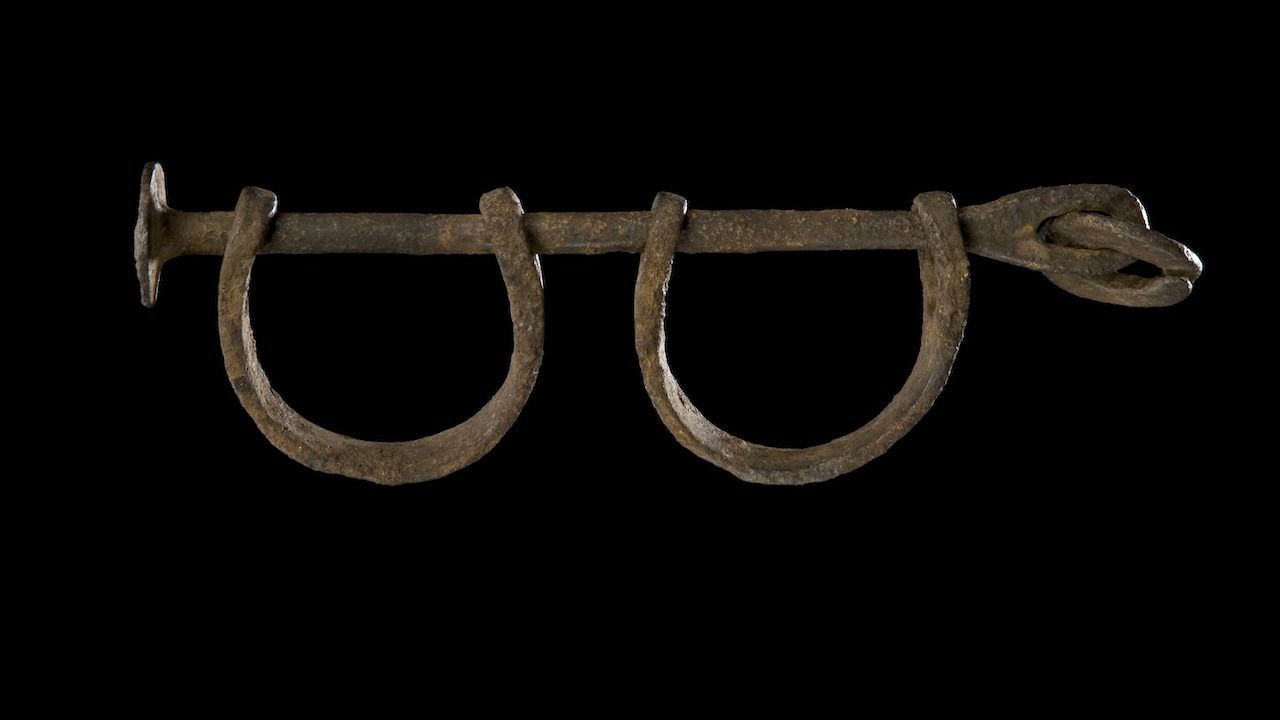
It would be unfair to rank one exhibit as more important than another since each is a piece of the puzzle that constitutes America. If you have only a few hours at your disposal, though, the following exhibits are a must-see for every visitor who wishes to connect the dots of history, note the remarkable progress, and aspire to go further forward.
1. Set of shackles (C3)
These heavily rusted iron loops joined together by an iron rod have been recovered among many artifacts from the São José shipwreck off the coast of Cape Town.
2. The wall of the domestic slave trade (C3)
As a result of the expansion of cotton cultivation, about “one million people were taken away from their families to vast plantations along the Mississippi River Valley.” Read their testimonies on the wall.
3. Stone slave auction block (C3)
Get a glimpse at this large gray carved marble with a flattened top and bottom, used in Hagerstown, Maryland, during 1830.
4. Silk lace and linen shawl given to Harriet Tubman by Queen Victoria (C3)
Harriet Tubman escaped slavery as a young woman in the early 1800s but returned to the South again and again to lead other African Americans to freedom.
5. Violin played by the enslaved man Jesse Burke (C3)
The violin belonged to Elijah Burke, owner of the Mount Pleasant Plantation in Phillips County, Arkansas. Before he died in 1860, he gave the violin to one of his enslaved men, Mr. Jesse Burke, who used to entertain the slaveholder and his guests.
6. Cabin from the Point of Pines Plantation in South Carolina (C3)
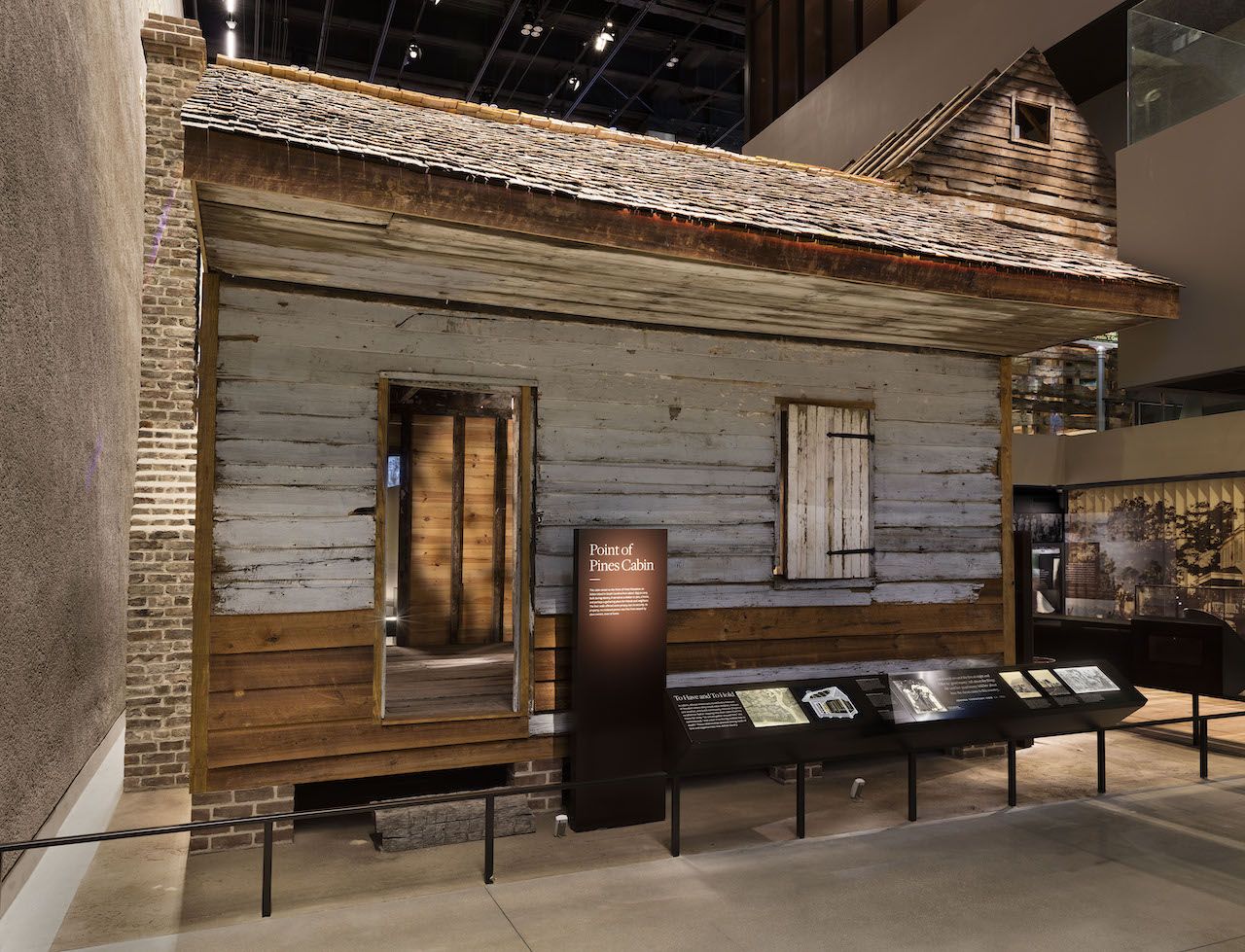
After emancipation, many African Americans returned to the plantations to find work and moved into the same cabins they occupied during slavery.
7. Interactive lunch counter (C2)
Inspired by college students’ bravery at a segregated Woolworth’s department store eatery, the lunch counter is an installation of interactive touch screens facing a panoramic news footage projection of the fights for equality. Sit on any of the counter stools and explore the menu of movements, from sit-ins to bus boycotts. This intriguing experience puts you in the shoes of freedom fighters. Even if you have to line up for one of the 12 stations, it’s definitely worth your time.
8. Segregated railroad car (C2)
This is one of the largest and most iconic exhibits demonstrating the brutal impacts of segregation under the Jim Crow era. Enter the car to witness the challenges African Americans faced during their travels around the country.
9. Angola Prison Tower (C2)
Sitting on a raised platform is a life-sized steel and concrete tower from one of America’s most brutal prisons.
10. Emmett Till Memorial (C2)
The casket of 14-year-old Emmett Till, who was murdered while visiting family in Mississippi in 1955 after whistling at a white woman is “one of our most sacred objects,” said Kinshasha Holman Conwill, the museum’s deputy director. The casket is placed on a pedestal in a separate room, and there’s a bench for those who wish to engage deeply with the significance of the exhibit. The young boy’s murder became a rallying point for the Civil Rights Movement.
11. The Oprah Winfrey Show exhibit (C1)
Oprah Winfrey is the first African American to host a national show, which aired for 25 years. This exhibit is a reproduction of the setting with original furniture and objects.
12. Dress designed by Tracy Reese and worn by Michelle Obama (C1)
Here the tour of the history galleries ends with the election of America’s first Black president. In the foreground of the many magazine covers and other memorabilia from the political campaign is the signature sleeveless black dress with red poppies that the First Lady wore in 2013 on the 50th Anniversary of the March on Washington.
The gallery you shouldn’t skip at the National Museum of African American History and Culture

The history galleries may occupy the majority of its physical space, but after diving into the past, you’d be remiss to skip the L galleries, which focus on African American community (L3) and culture (L4).
In comparison to the history galleries, the L galleries are bright, airy, and spacious. From the heritage hall, take the escalators to community galleries. In the “Making a Way Out of No Way” exhibits, you’ll see how African Americans have resisted and persisted, thanks to mutual support and through education, religion, entrepreneurship, and activism. Personal success stories are spotlighted here in spite of obstacles and lack of opportunity. Stories include those of Dr. Mary McLeod Bethune, who founded the National Council of Negro Women in 1935, and photojournalist Charles Harris, whose work now sits in the Carnegie Museum of Art. One room is dedicated to boxer and activist Muhammad Ali whose “stand for his personal, political, and religious convictions changed American history,” as the display reads.
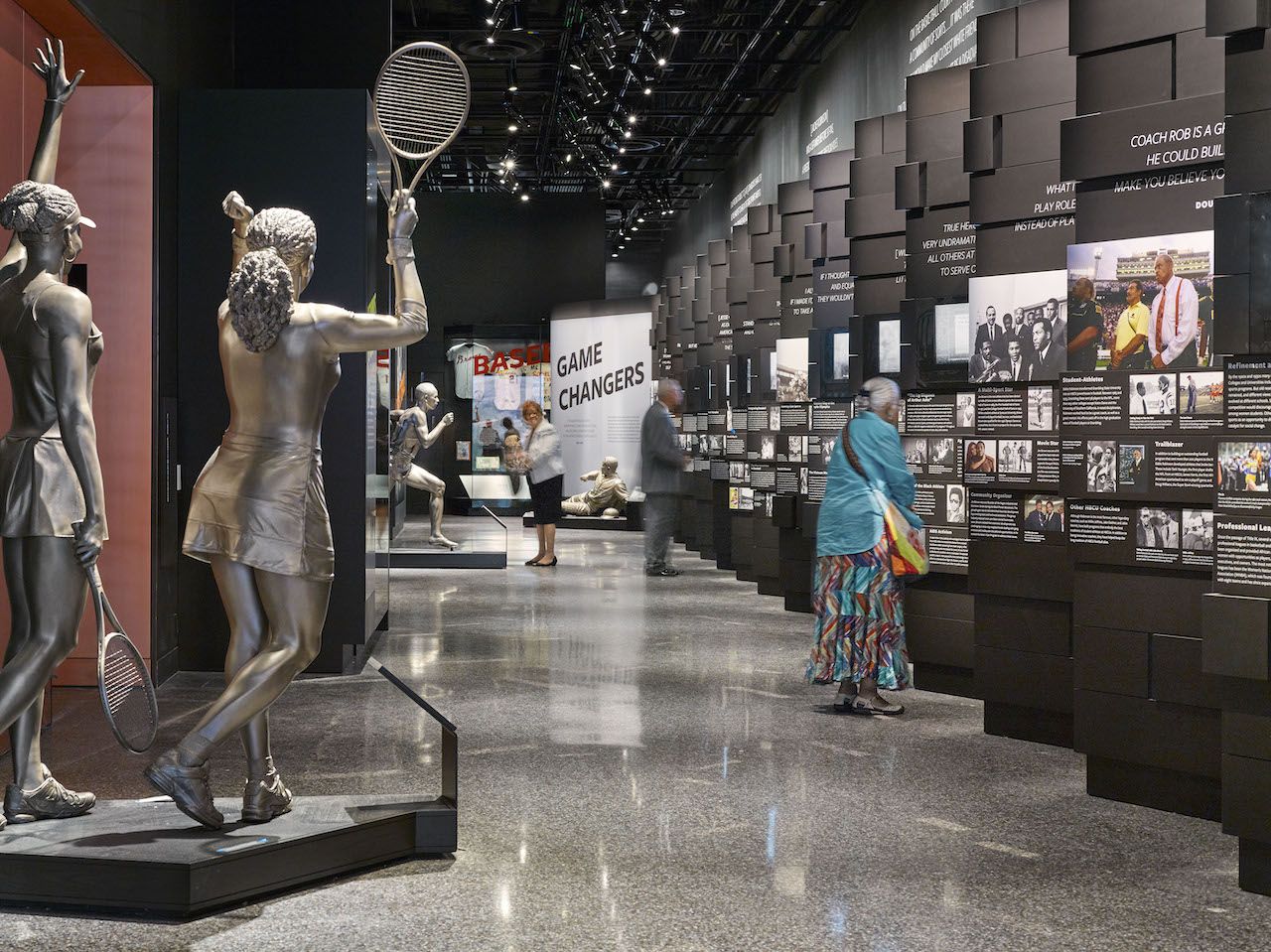
The chronological exploration of African American activism that began in the concourse exhibitions continues here through participation in sports with memorabilia — such as Michael Jordan’s jersey, Joe Louis’s boxing gloves, and Gabby Douglas’s bar grips — and the statues of Venus and Serena Williams. Besides manifesting their physical ability and talent, many athletes used the fields, courts, and rings as a platform for social and political justice and equality.
In the Power of Place room, an interactive multimedia table features personal stories on identity. Migration, displacement, and travel are matters that touch communities globally, and this is a great opportunity to reflect on those. If you are running out of time, but you feel inspired, you can submit your story and images online. If you have time and want to pay respects to the African American soldiers who served in the military from the American Revolution to the War on Terror, visit the Double Victory exhibition on L3.
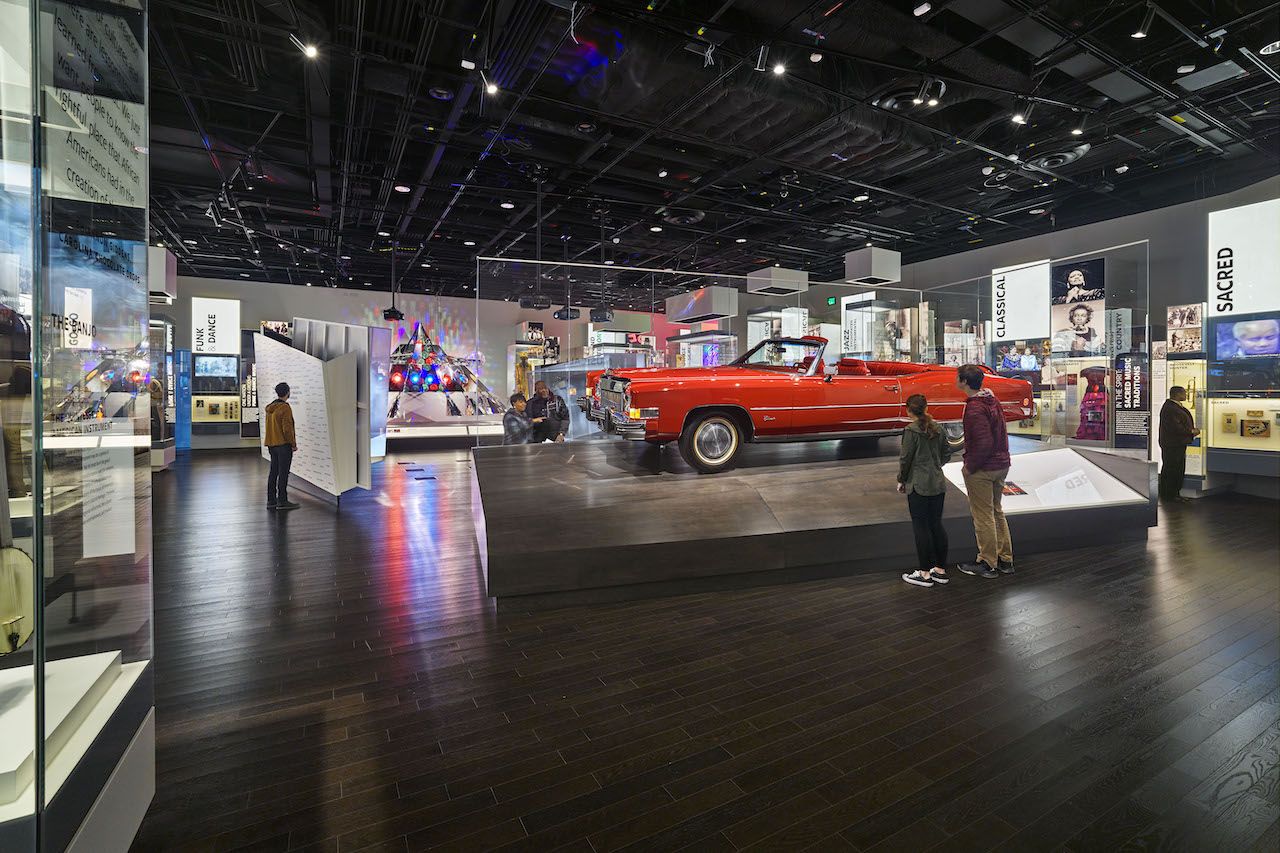
Next, L4 welcomes you with an impressive multimedia installation named “Cultural Expressions,” which focuses on style, cuisine, creativity, language, and dance. The musical crossroads hall — where you can see Sammy Davis Jr.’s tap shoes, Jimi Hendrix’s vest, and Chuck Berry’s red Cadillac — takes you through multiple genres of African American music. The speakers are on blast, and it’s very likely to see visitors moving to the beats of Chuck Berry, 2Pac, or Whitney Houston. You have just joined a party celebrating one of America’s most important cultural exports: music. Visual arts enthusiasts should leave themselves time to visit the dedicated gallery on L4. Paintings, sculptures, and drawings show how artists interpreted the history of their nation from the beginning of the 19th century to contemporary times.
The most underrated exhibitions to check out at the National Museum of African American History and Culture
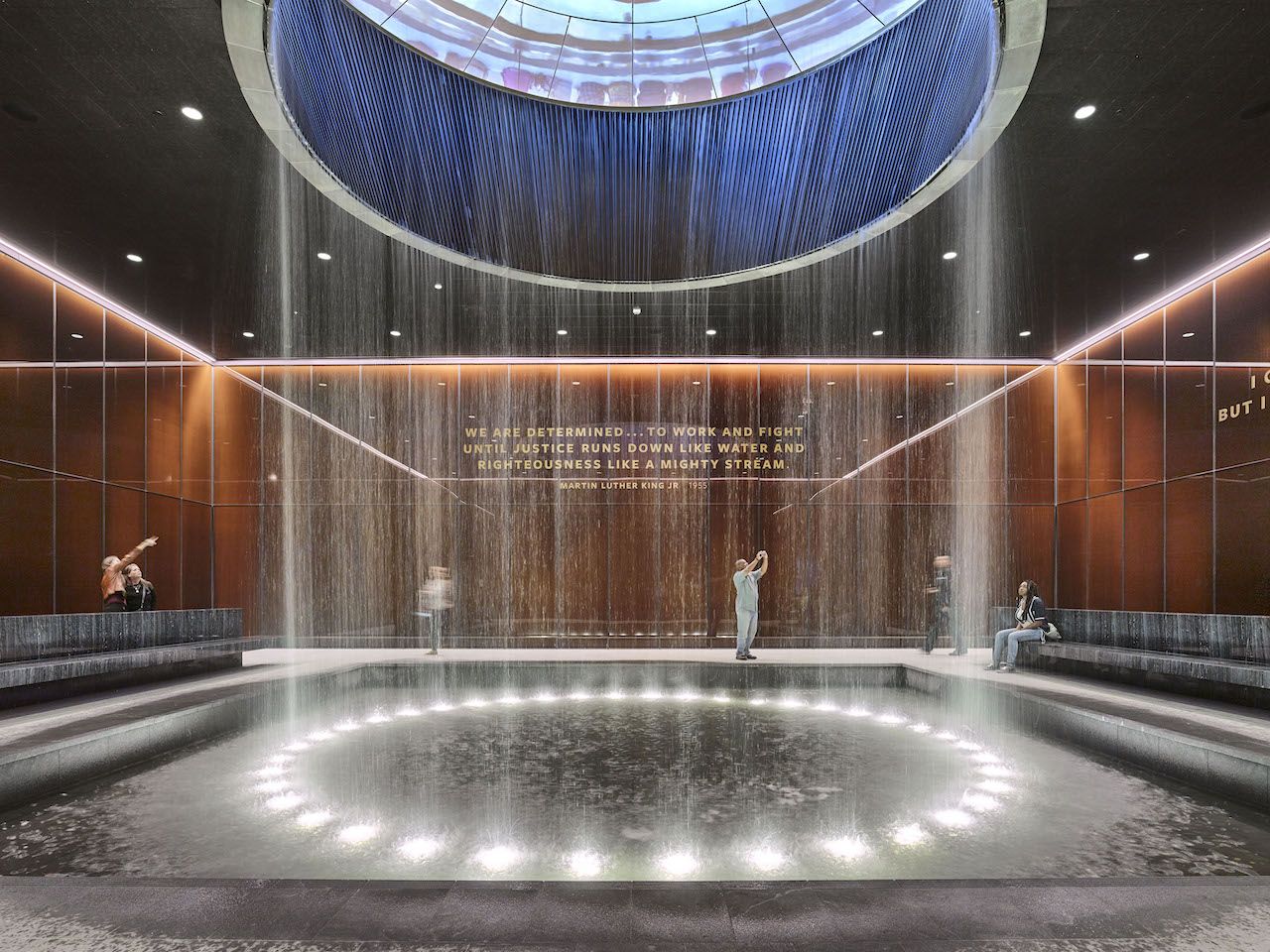
If you’ve walked through all of the history galleries, you’ve covered more than a mile and centuries of history. As you make your way through, you may notice that the concourse galleries are cramped, and the only seating areas are in the designated “reflections” spaces. This is what makes the Contemplative Court by the exit to the history galleries such a thoughtful addition to Concourse C.
The Contemplative Court is a calm, reflective space and virtual transition from the dark past to the future. The soothing effect of the water that falls powerfully and uninterruptedly from a skylit oculus on the ceiling in the center of the room brings the catharsis you have been looking for after acknowledging your role in history. But at the end of the day, it’s a shared history. A quote by Dr. Martin Luther King Jr. on the wall across reads, “We are determined to work and fight until justice rains down like water and righteousness like a mighty stream.”
The L galleries also have a bonus gallery that should not be overlooked. Visit L2 to explore interactively more stories, images, and objects from the museum’s vast collection. This open space will capture the attention of all ages and is appealing to younger kids.
Before you leave the National Museum of African American History and Culture
While food and drink are prohibited in the galleries, make time for lunch or a snack at the Sweet Home Café opposite the Contemplative Court. You may also want to leave time at the end of your visit to peruse the African American literature in the museum store. (While the store stays open until 5:30 PM, the last entrance is at 5:00 PM.)
A version of this article was previously published on January 17, 2020, and was updated on March 23, 2022.
Source https://nmaahc.si.edu/visit/plan-your-visit
Source https://www.discoverwalks.com/blog/united-states/top-10-facts-about-the-national-museum-of-african-american-history-and-culture/
Source https://matadornetwork.com/read/national-museum-african-american-history-culture/